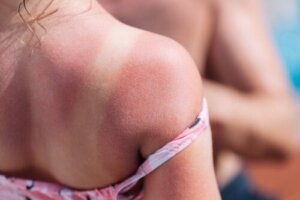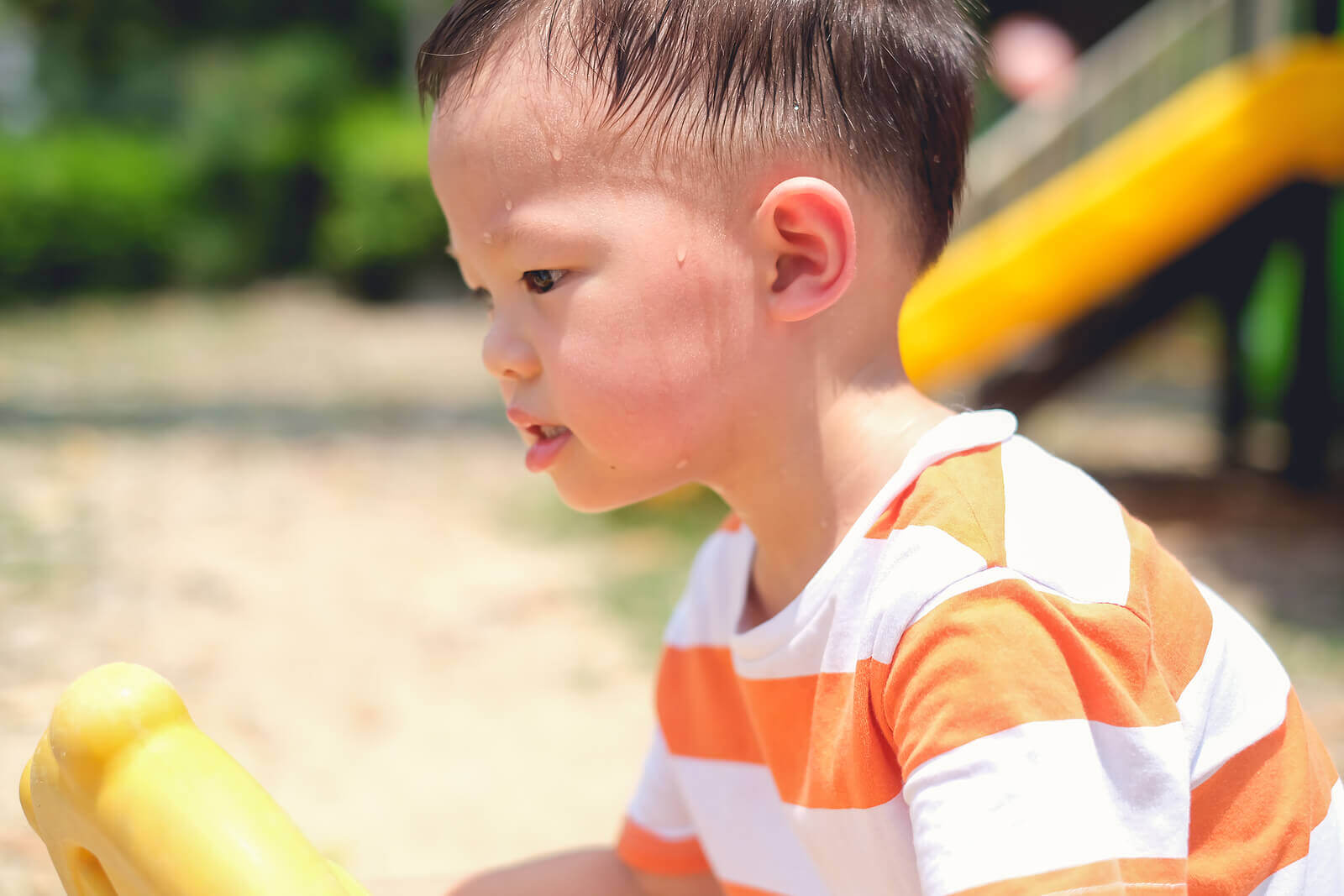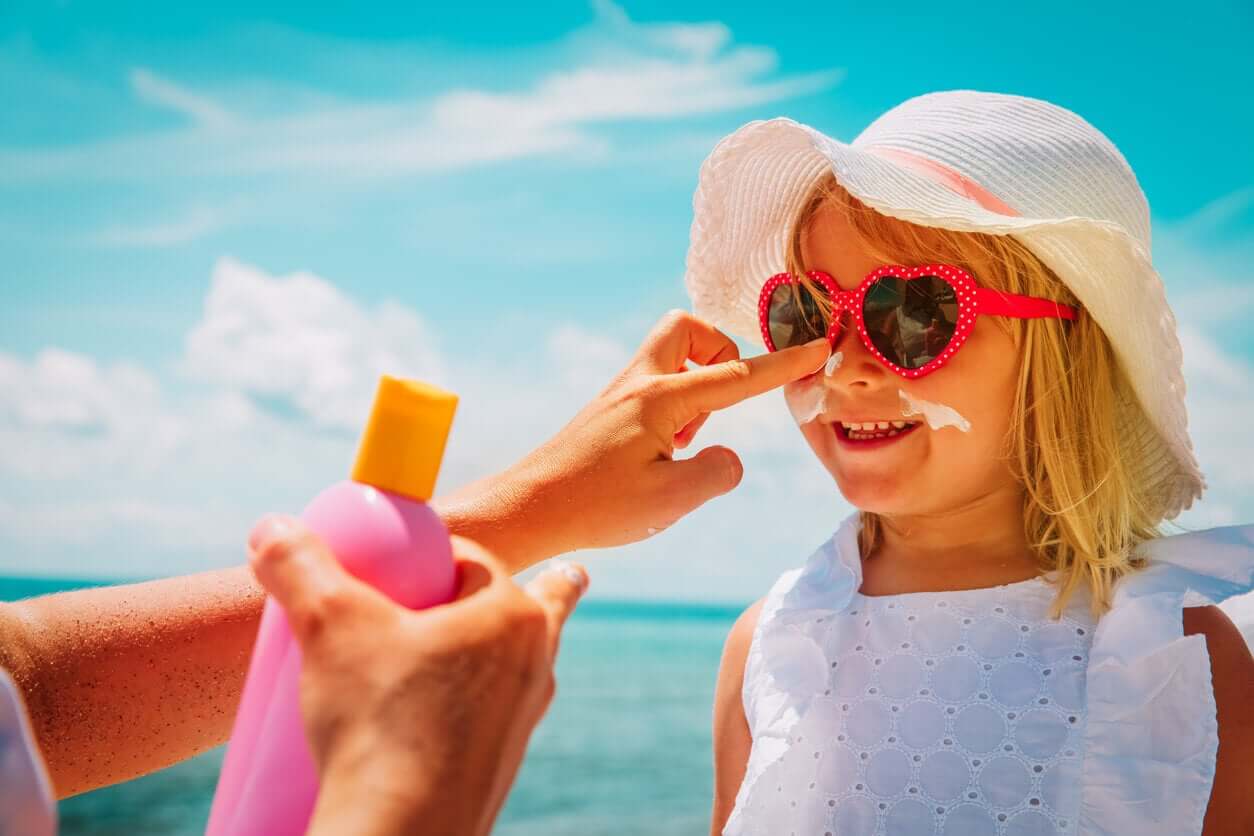Sunburn in Children: Why Is It So Dangerous?


Written and verified by the dermatologist Maria del Carmen Hernandez
Skin cancer is a preventable disease. For this reason, it’s important to educate children from an early age about the importance of sunburn prevention. Sunburn in children not only causes immediate damage but also increases the risk of malignant lesions in the future.
Do you want to know more about this important topic? Don’t miss out on all the information that we’ve prepared for you.
How to recognize sunburn in children?
Fair-skinned children are more sensitive to sunburn than dark-skinned children because they have less melanin in their skin. However, children with dark skin can also get sunburned.
These injuries that result from UV exposure vary in severity: From mild superficial redness to blisters, severe pain, or swelling of the skin (edema).
In general, most sunburn injuries become more visible several hours after the damage occurs. For this reason, the manifestations cause greater discomfort between 24 and 48 hours after exposure.
The consequences of sunburn in children
In the long term, sunburn in children increases the chances of developing skin cancer, especially melanoma. Even in adults, it favors premature aging of the skin and the formation of wrinkles from an early age.
Skin cancer
We know that skin cancer is a tumor that grows in the cells of this tissue in an uncontrolled way. The three most common types of skin carcinomas include the following:
- Basal cell carcinoma: Very treatable, slow-growing cancer
- Squamous cell carcinoma: Is more aggressive compared to basal cell carcinoma and is very treatable
- Melanoma: Can spread more quickly
Although skin cancer isn’t one of the most common in childhood, the risk of developing it increases by 2% each year. In fact, melanoma accounts for about 3% of childhood cancers and is closely related to bullous-type burns in childhood and adolescence.
You may be interested: Impetigo in Children: Types, Symptoms and Treatment
Heatstroke
Heatstroke occurs when the child is directly exposed to high temperatures and for a long period of time. The body, as a result, loses the ability to regulate temperature and dehydrates its tissues.
Some of the typical clinical signs of this condition manifest the damage that occurred at the level of the central nervous system. Among them, the following stand out:
- Loss of balance and impaired gait (ataxia)
- Confusion
- Delirium
- Seizure
A review in Current sports medicine reports concluded that children are more susceptible to heatstroke than adults.

Measures to avoid sunburn in children
The skin contains a natural pigment called melanin, which increases its production as a result of exposure to ultraviolet sunlight. In this way, the skin darkening typical of tanning occurs.
But, in addition to aesthetic issues, the sun’s rays can cause skin damage that should be avoided. Next, we’ll go into detail regarding those prevention habits that are important to adopt and instill from childhood.
Avoid exposure at certain times of the day
Children’s skin burns more easily than adults, so special care must be taken. Taking advantage of the shade is always an excellent way to protect them.
However, it’s important to know that some surfaces (such as sand, water, or snow) tend to reflect ultraviolet rays, so hiding under an umbrella or a tree isn’t always enough.
As a general rule, it’s important to avoid sun exposure during the most intense hours of sun, that is, between 10 am and 3 pm.
Read also: 10 Skincare Tips for Babies and Children
Use of sunscreen
The choice of sunscreen is one of the most important steps when it comes to preventing sunburn in children. It must be broad-spectrum, with an SPF greater than 30, and waterproof.
The application of sunscreen should take place 30 minutes before sun exposure and be renewed every two hours or sooner if the child sweats or gets wet.
However, you shouldn’t place these products on the skin of children under 6 months of age.
Read more: Apply Sunscreen for Moles and Freckles
Other protective measures
Ideally, your child should cover as much skin as possible with their clothing. Currently, there’s a wide variety of clothing that protects against ultraviolet rays, which has an ultraviolet protection factor (UPF) of 50+.
In turn, the use of hats that protect the neck, face, and ears and sunglasses with sun protection are also excellent accessories.

Sunburn in children and its future consequences
Tanning isn’t a healthy habit and, in fact, it’s a sign that the skin’s been damaged by ultraviolet rays and tries to protect itself from even greater injuries.
The accumulation of sun damage throughout life significantly increases the chances of developing skin cancer in the future.
Skin cancer is a preventable disease. For this reason, it’s important to educate children from an early age about the importance of sunburn prevention. Sunburn in children not only causes immediate damage but also increases the risk of malignant lesions in the future.
Do you want to know more about this important topic? Don’t miss out on all the information that we’ve prepared for you.
How to recognize sunburn in children?
Fair-skinned children are more sensitive to sunburn than dark-skinned children because they have less melanin in their skin. However, children with dark skin can also get sunburned.
These injuries that result from UV exposure vary in severity: From mild superficial redness to blisters, severe pain, or swelling of the skin (edema).
In general, most sunburn injuries become more visible several hours after the damage occurs. For this reason, the manifestations cause greater discomfort between 24 and 48 hours after exposure.
The consequences of sunburn in children
In the long term, sunburn in children increases the chances of developing skin cancer, especially melanoma. Even in adults, it favors premature aging of the skin and the formation of wrinkles from an early age.
Skin cancer
We know that skin cancer is a tumor that grows in the cells of this tissue in an uncontrolled way. The three most common types of skin carcinomas include the following:
- Basal cell carcinoma: Very treatable, slow-growing cancer
- Squamous cell carcinoma: Is more aggressive compared to basal cell carcinoma and is very treatable
- Melanoma: Can spread more quickly
Although skin cancer isn’t one of the most common in childhood, the risk of developing it increases by 2% each year. In fact, melanoma accounts for about 3% of childhood cancers and is closely related to bullous-type burns in childhood and adolescence.
You may be interested: Impetigo in Children: Types, Symptoms and Treatment
Heatstroke
Heatstroke occurs when the child is directly exposed to high temperatures and for a long period of time. The body, as a result, loses the ability to regulate temperature and dehydrates its tissues.
Some of the typical clinical signs of this condition manifest the damage that occurred at the level of the central nervous system. Among them, the following stand out:
- Loss of balance and impaired gait (ataxia)
- Confusion
- Delirium
- Seizure
A review in Current sports medicine reports concluded that children are more susceptible to heatstroke than adults.

Measures to avoid sunburn in children
The skin contains a natural pigment called melanin, which increases its production as a result of exposure to ultraviolet sunlight. In this way, the skin darkening typical of tanning occurs.
But, in addition to aesthetic issues, the sun’s rays can cause skin damage that should be avoided. Next, we’ll go into detail regarding those prevention habits that are important to adopt and instill from childhood.
Avoid exposure at certain times of the day
Children’s skin burns more easily than adults, so special care must be taken. Taking advantage of the shade is always an excellent way to protect them.
However, it’s important to know that some surfaces (such as sand, water, or snow) tend to reflect ultraviolet rays, so hiding under an umbrella or a tree isn’t always enough.
As a general rule, it’s important to avoid sun exposure during the most intense hours of sun, that is, between 10 am and 3 pm.
Read also: 10 Skincare Tips for Babies and Children
Use of sunscreen
The choice of sunscreen is one of the most important steps when it comes to preventing sunburn in children. It must be broad-spectrum, with an SPF greater than 30, and waterproof.
The application of sunscreen should take place 30 minutes before sun exposure and be renewed every two hours or sooner if the child sweats or gets wet.
However, you shouldn’t place these products on the skin of children under 6 months of age.
Read more: Apply Sunscreen for Moles and Freckles
Other protective measures
Ideally, your child should cover as much skin as possible with their clothing. Currently, there’s a wide variety of clothing that protects against ultraviolet rays, which has an ultraviolet protection factor (UPF) of 50+.
In turn, the use of hats that protect the neck, face, and ears and sunglasses with sun protection are also excellent accessories.

Sunburn in children and its future consequences
Tanning isn’t a healthy habit and, in fact, it’s a sign that the skin’s been damaged by ultraviolet rays and tries to protect itself from even greater injuries.
The accumulation of sun damage throughout life significantly increases the chances of developing skin cancer in the future.
All cited sources were thoroughly reviewed by our team to ensure their quality, reliability, currency, and validity. The bibliography of this article was considered reliable and of academic or scientific accuracy.
- Bytomski JR, Squire DL. Heat illness in children. Curr Sports Med Rep. 2003 Dec;2(6):320-4. doi: 10.1249/00149619-200312000-00007. PMID: 14583161.
- Gilaberte Y, Carrascosa JM. Sun protection in children: realities and challenges. Actas Dermosifiliogr. 2014 Apr;105(3):253-62. doi: 10.1016/j.adengl.2013.05.006. Epub 2014 Mar 21. PMID: 24661953.
- Emmett A, Uchida T, Wagner RF Jr. Sunburn risk factors for beachgoing children. Dermatol Online J. 2008 Jan 15;14(1):28. PMID: 18319045.
- Gambichler T, Altmeyer P, Hoffmann K. Role of clothes in sun protection. Recent Results Cancer Res. 2002;160:15-25. doi: 10.1007/978-3-642-59410-6_3. PMID: 12079208.
This text is provided for informational purposes only and does not replace consultation with a professional. If in doubt, consult your specialist.








